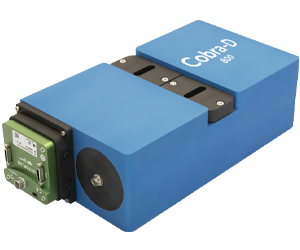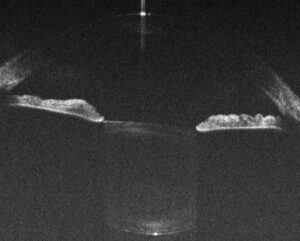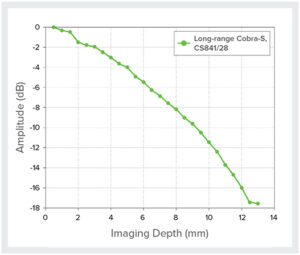GRATINGS +1 435.752.4301 SPECTROMETERS +1 919.544.7785 OCT +1 919.544.7785
GRATINGS +1 435.752.4301 SPECTROMETERS +1 919.544.7785 OCT +1 919.544.7785
 OCT imaging has traditionally required the use of longer wavelengths to probe depths greater than a few millimeters in a single scan, bringing with it the higher cost associated with NIR detectors. That’s why we have developed an optical spectrometer design that allows us to achieve imaging depths of up to 12 mm using 800 nm OCT, which opens up new possibilities for cost-effective measurement of features over a wider range of depths.
OCT imaging has traditionally required the use of longer wavelengths to probe depths greater than a few millimeters in a single scan, bringing with it the higher cost associated with NIR detectors. That’s why we have developed an optical spectrometer design that allows us to achieve imaging depths of up to 12 mm using 800 nm OCT, which opens up new possibilities for cost-effective measurement of features over a wider range of depths.
Applications that can benefit from long-range imaging include ophthalmology, medicine, and nondestructive process monitoring of additive printing and laser machining. Due to the high stakes in these applications, we’ve backed the performance of our Cobra-D models with industrial-grade mechanical and thermal stability.
In materials processing applications, surface morphology provides valuable information as materials are deposited, machined, or modified. Both the resolution and the depth range of information of the imaging system used are important, as they determine what answers can be extracted. The ability to image deeper also facilitates wide-field imaging, as the full profile and structure of curved or irregular surfaces can be captured in a single scan. This is especially important in laser machining and welding, where a particular cut or hole may run deep, and for profiling complex surfaces in additive manufacturing.

In ophthalmology, long-range imaging is beneficial for examination of the full anterior chamber, from cornea to crystalline lens, as it permits a more complete image of the eye to be acquired in less time for assessment of eye health. It can even be used to image the whole eye if configured appropriately. It also facilitates wide-field imaging of the retina, the curvature of which requires a greater range of imaging depth, particularly in clinical settings where the patient is unlikely to remain static.
In medicine, long-range OCT can be of great benefit for lumen imaging in intravascular and gastrointestinal applications. In such scenarios the structures of interest may be more than a few millimeters from the imaging catheter, and therefore fall outside the typical OCT imaging window. A long imaging depth can account for such variability in distance between the imaging probe and area of interest, facilitating better imaging outcomes.
Imaging range in SD-OCT depends on both the center wavelength, and on the bandwidth of the light source. As center wavelength increases, so too does the imaging depth (at the expense of spatial resolution). Traditionally, 1300 nm has been the preferred wavelength when imaging depths more than a few millimeters are needed, particularly for highly scattering materials like tissue. Use of this wavelength requires InGaAs cameras, however, which are significantly more expensive than the CCD or CMOS cameras used for 800 nm SD-OCT. By moving to a shorter center wavelength (CWL), the spectrometer cost can be reduced by ~40%, but the bandwidth (BW) must be also be reduced in order to maintain the same spatial resolution.
This drives the bandwidth for an 800 nm long-range imaging system to below 30 nm for an imaging depth of 12 mm in order to maintain equivalent spatial resolution. While it is possible to increase the dispersion of the grating in the spectrometer to achieve this, the optical design must also be capable of resolving the light falling on each adjacent pixel. This translates into extremely high spectral resolution – below 0.02 nm!
To translate the benefits of long-range imaging to 800 nm SD-OCT, we have applied our expertise in spectrometer design to develop an OCT spectrometer series with ultra-fine spectral resolution – the Cobra-D series shown below. These 800 nm OCT spectrometers deliver the same depth and axial resolution as their NIR equivalents, with many important benefits:

Our new Cobra-D series 800 nm OCT spectrometers have been designed to minimize roll-off with diffraction-limited optics and a low-crosstalk detector, ensuring high clarity images even at extended depths. Axial resolution is similar to the comparable model from our Cobra 1300 series, or slightly better.
>> Learn how to set up your Cobra spectrometer, or explore frequently asked questions related to its setup & operation.
| CD800-841/28 | CD800-840/40 | CD800-840/60 | CD800-840/80 | |
|---|---|---|---|---|
| Imaging Depth | 12.9 mm | 9.0 mm | 6.0 mm | 4.5 mm |
| Wavelength Range | 827-855 nm | 820-860 nm | 810-870 nm | 800-880 nm |
| Bandwidth | 28 nm | 40 nm | 60 nm | 80 nm |
| Spectral Resolution | 0.015 nm | 0.02 nm | 0.03 nm | 0.04 nm |
| Max Line Rate | 20 kHz, 80 kHz, 130 kHz, or 250 kHz | |||
| Pixels | 2048 | |||
| Interface | USB 3.0 (up to 130 kHz) or Camera Link (up to 250 kHz) | |||
| Dimensions | 27.8 x 13.4 x 7.9 cm | |||
| Weight | 5.5 kg | |||
Cobra Depth series part numbers are of the format CD800-[CWL]/[BW]-[kHz]-[camera][pixels]-[interface], where the e2v OctoPlus camera is represented by “OC”, 2K denotes 2048 pixels, and the interface is either camera link (up to 250 kHz, denoted by “-CL”) or USB 3.0 (up to 130 kHz, , denoted by “-U3”). Imaging depth stated is the theoretical value, calculated in air.
Visit our OCT Image Gallery